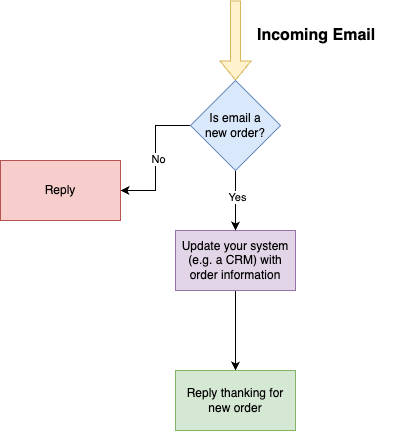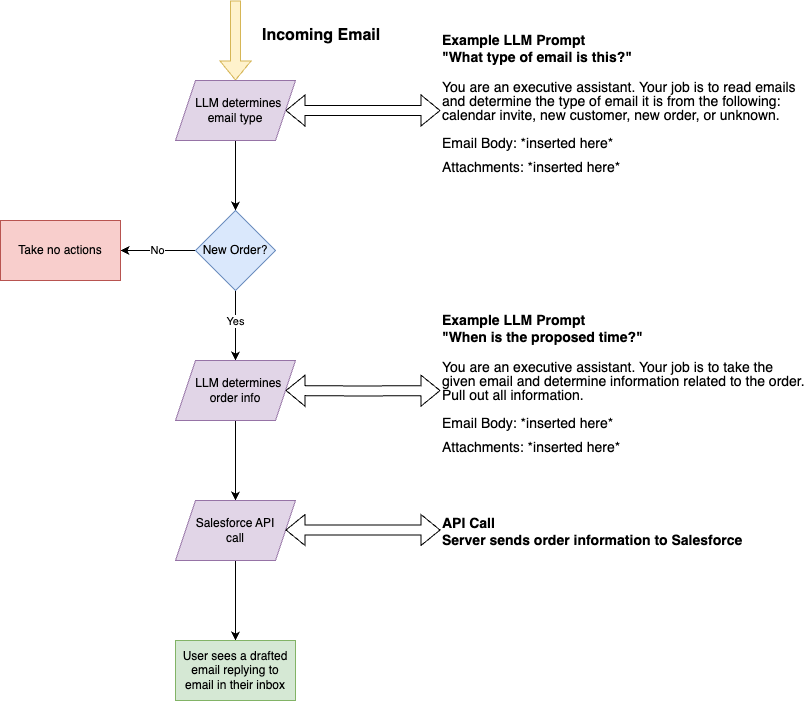AI is much like the word “transportation”: it’s a broad term that covers many different tools and technologies, each serving a unique purpose. Just as transportation can mean anything from bicycles to airplanes, AI encompasses a wide range of solutions, from data analytics to machine learning. In this post, we’ll be focusing on one specific type: large language models (LLMs).
Before diving into LLMs, let’s first consider how humans process information. Imagine receiving an email for a new order. Without much thought, you quickly recognize it’s an order request, open the attachments, update your system (like a CRM), and then reply to confirm. This whole process happens almost automatically, requiring little conscious effort on your part.

Humans have intuition and experience to determine next actions; computers just follow rules and data.
Unlike humans, who can rely on intuition and experience to make decisions, LLMs need clearly defined data and rules to perform tasks. They excel when given specific instructions and structured information, making them powerful components in your workflows.
From here on out, we’re going to pretend you run a print shop and we’ll see how we’d go about creating automations & augmentations to your process.
To start, an API is a tool that allows different software systems to communicate with each other. When you send information to an API, it’s like placing an order at a restaurant: you provide specific details on what you’d like from the menu (the request), and the kitchen (the server) processes that information behind the scenes. Once it’s ready, the food (the response) is delivered back to you. For example, when you use a service like ChatGPT, the website sends your question to its server, where the response is generated and sent back for you to see.

In automation, APIs become even more powerful because they enable systems to work together. Automating a process is essentially about chaining these API calls together. Each API handles a specific task, and by connecting them in a sequence, you can automate an entire workflow.
For example, when an email arrives, the first API call could be made to ChatGPT to identify the type of email – whether it’s a new order, an inquiry, or something else. If ChatGPT determines it’s a new order, the system would make another ChatGPT API call to extract key details like the order amount, items, and specifications. With this information in hand, a final API call would update your internal system, such as Salesforce, automatically logging the order. By chaining these API calls together, you create a fully automated process that handles data entry, streamlines your workflow, and saves valuable time.

Before we move on to learning about how we implement ways of having this workflow improve over time, we’re going to go through a real-life example of building out seemingly “impossible” tasks:
Building Your Dream Process
Let’s take an example: a financial advisor came to us with an intriguing request. He gets many inbound leads from his website and referrals where his current process was to reach out to each person individually. As you can imagine, some referrals are worth more business to him than others. He told us, “I know it’s not possible, but I wish I could determine the net worth of leads to prioritize who to reach out to.” After diving into his challenge, we found a way to deliver exactly what he thought was impossible.
We researched different data providers and combined multiple services to augment his process. Using the information from incoming leads (full name, phone number, and / or email), we created a workflow that would search LinkedIn for their profile, identify their current address, and apply AI to classify leads into categories like high-net-worth (HNW), medium-net-worth, low-net-worth, or unknown. When a HNW individual was detected, the system would send a text alert to the advisor, prompting an immediate follow-up. Not only that, but a drafted email was ready to send in their email provider, and all the lead information was automatically pushed into their CRM.
The result? A fully automated system that streamlined high-priority lead management. And the cost to implement and maintain this solution was just $0.50 per lead, with no upfront development costs. This is the kind of practical and powerful automation we bring to businesses, unlocking opportunities they didn’t think were possible.
Read More ->
